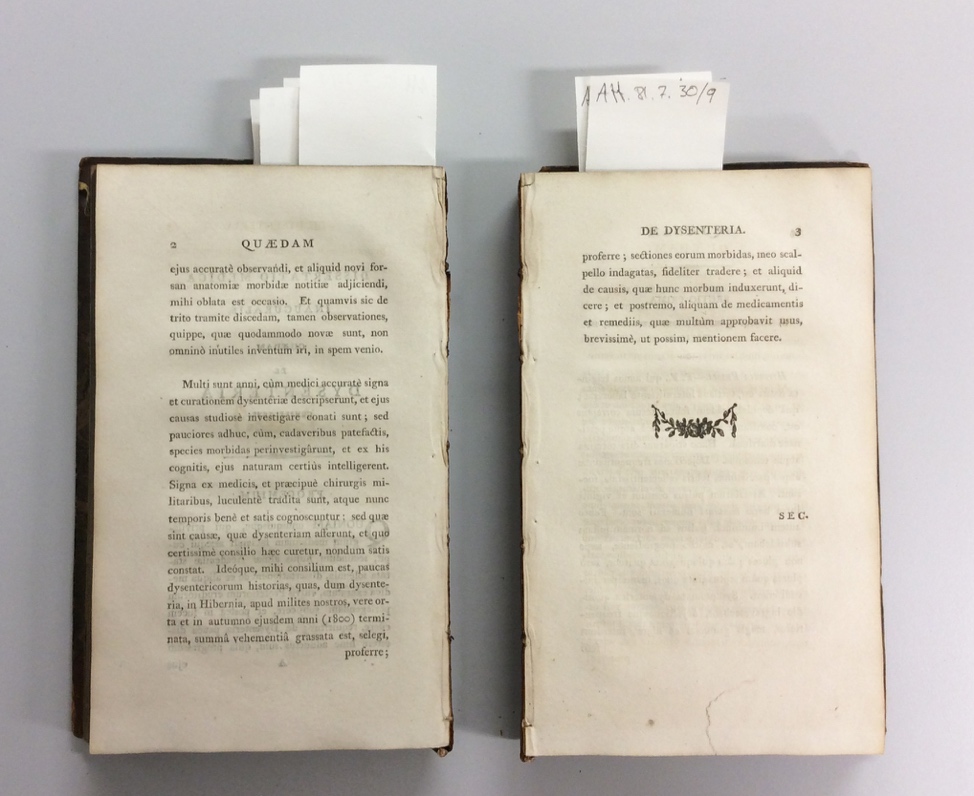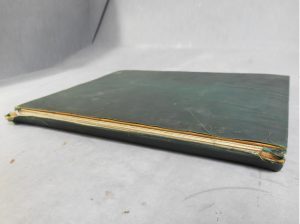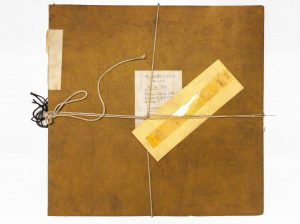In this post conservator Amy Baldwin talks about working with the University of St Andrews to help develop their new arsenic identification tool.
Tag Archives: book conservation
Giving Decorated Paper a Home … Loose-leaf Material
In this post, Technician Robyn Rogers discusses her bespoke mounting and rehousing of loose-leaf papers from the University’s decorated paper collection. Robyn’s first post about working through the collection’s bound volumes can be seen here. If you are interested in learning more about the historic uses, production and trade of decorated paper, you can visit the online exhibition on this collection, curated by Elizabeth Quarmby Lawrence here.
Conserving calligraphy: preparing Esther Inglis’ manuscripts for digitisation
In this post book conservator Amy Baldwin talks about the conservation work undertaken on volumes appearing in the upcoming online exhibition “Rewriting the script: the works and words of Esther Inglis”.
Sustainable Exhibition Making: Recyclable Book Cradles
In this post, our Technician, Robyn Rogers, discusses the recyclable book cradles she has developed as part of the conservation team’s ongoing work to make exhibitions at the University of Edinburgh more sustainable.
The Book Surgery Part 2: Bringing Everything Together
In this blog, Project Conservator Mhairi Boyle her second day of in-situ book conservation training she has undertaken with Book Conservator Caroline Scharfenberg (ACR). Mhairi previously undertook a Maternity Cover contract at the CRC within the Conservation Department.
In the previous blog, the examination and initial steps in spine repair and board reattachment of two volumes from the Royal (Dick) School of Veterinary Studies (R(D)SVS) were described. The first blog in this series can be found here.
After my first session with Caroline, I sat down and pored over all my notes and the millions of photos I had taken. The amount of thought, precision and care that goes into book spine linings and repairs that will eventually be hidden and concealed shows how complex even in-situ book conservation steps can be. After jotting down my notes into a coherent order and cross-referencing everything with Caroline, I came back to the studio a few weeks later refreshed and ready for a full day of training and collaboration.
In this session, Caroline and I focused on making spine pieces and hollows, and examined how to reattach cracked book boards in different ways. One of the things I like most about working in Conservation is that we are constantly adapting and evolving techniques, tailoring them to the objects we are currently working on. This is exactly what Caroline demonstrated to me: informed by our initial examinations of both volumes, we tailored the treatment steps for each book based on its size, weight, and particular areas of weakness.
A Book of Two Halves
Our Projects Conservator, Nicole, describes a technique for repairing books that have broken in half in this week’s blog…
I have now moved full time to the conservation studio at the main library and I have started working on the Latin thesis from 1726 – 1826 which contain a number of PhD thesis in one leather binding.
The majority of this collection is in good condition with just under half needing conservation treatment before digitisation, mostly quick treatments such as being board reattachment. A small number of volumes have been rebound with a hollow and using book cloth which makes them more accessible and easier to be digitised. However, 46 volumes have broken sewing resulting in the text block breaking in half or in some cases three or four separate pieces. This has been caused by repeated use, and forcing the volumes open.

An example of a Latin thesis broken in half, before conservation
PhD Theses Conservation
My name is Nicole and I am excited to be in my fourth week as the new digitisation project conservator working on conserving the PhD theses before digitisation. The PhDs I am working on range from 1750–1961 and are mostly bound. The volumes vary in size and material. The earlier volumes are bound in leather and hand written, while the later volumes are bound in book cloth and typed.
At present my time is split between two locations for conserving the PhDs: the Library Annex and the Main Library conservation studio.
So far I have mainly been working on the medical PhDs which include some beautiful and what must have been very time consuming drawings. The volumes also house many photographs and x-rays, including the x-ray of a shilling swallowed by a patient!
My current conservation work focuses on the volumes which had been flagged up by the survey carried out prior to my arrival. The treatments I have undertaken so far include surface cleaning, consolidation of red rot using Klucel G in IMS, inner joint repair to reattach loose or detached boards, minor paper repairs and reattaching damaged spines to volumes using a hollow made from archival paper.

Detached spine on bound volume
The aim of the conservation work is to stabilise the volumes for digitisation and to ensure the text and imagery are visible. On occasion rehousing is needed, made out of archival board.

Thesis to be rehoused
Keep an eye out for updates on this project!
Book conservation skills for paper conservators
This week’s blog post comes from Projects Conservator, Katharine Richardson, who recently attended a workshop to learn basic book conservation techniques….
Last month I attended a two day workshop, Book Conservation Skills for Paper Conservators, at the National Library Scotland. The course aimed to teach paper conservators basic practical book conservation skills. It was led by our friend and colleague, Caroline Scharfenberg, who is an accredited, freelance book conservator based at the University of Edinburgh Conservation Studio. I was very excited to learn a bit more about Caroline’s practice, and it was a great opportunity for me to get away from my desk for a bit and learn some new interventive conservation skills.
On the first day Caroline gave a series of lectures on the theory and ethics involved in book conservation as well as a brief history of book binding. We were then able to put some of the theory into practice through a practical exercise preparing a condition assessment and treatment proposal for some of the National Library’s book collections.

Class preparing their condition assessment and treatment proposals
